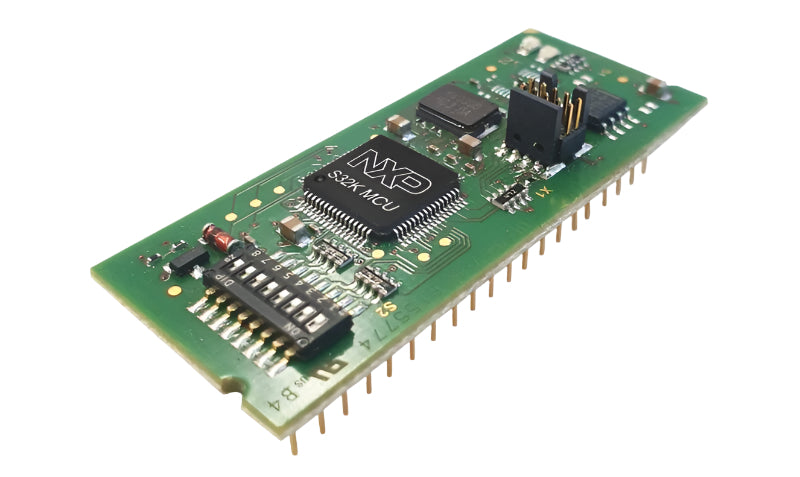
CANopen Chip CoC-100
Integrate seamlessly with hardware using pre-programmed CANopen firmware.
(These chips are the suggested replacements for CANopen Chip-F40: SKU # SYS-MM-217-Y)
Enable seamless communication between devices from different manufacturers with the CANopen chip CoC-100. Easily expand your network of devices without the need for extensive reconfiguration using the comprehensive range of inputs and outputs. Manage your network with ease as the controller chip takes care of tasks such as device configuration, error detection, and diagnostics.
The CANopen Chip CoC-100 integrates seamlessly with hardware using pre-programmed CANopen firmware and an integrated standard DIP-40 connector. It’s a versatile communications interface ideal in industries such as automation, medical, and transportation.
Experience up to 7 I/O configurations for superior interoperability in even the most complex systems. The CANopen chip possesses versatility and flexibility offering a range of digital inputs and outputs along with analog inputs and pulse-width modulation outputs. As a slave device, the CANopen Chip CoC-100 guarantees reliable and secure data transfer.
Key Features:
- FD tolerant
- Future-proof use thanks to the NXP S32K142 controller
- Usable in 5V or 3.3V operation
- Higher accuracy of the AD converter - 12 bit
- CANopen bootloader for firmware update via the CAN bus
- Single board CANopen I/O-node in 40-pin DIP dimensions (24x56mm) populated with NXP S32K142 32-bit microcontroller
- Controller signals and ports extending to standard-width (2.54 mm.) pin rows lining the edges of the board
- CAN signals (CANH, CANL) in CAN 2.0B passive mode
- Reference voltage pins for the on-chip A/D-converter
- Non-volatile storage of CANopen configuration parameters
- 5.0V on-board MCP2562 CAN transceiver (4003001)
- 3.3V on-board TCAN337GDR CAN transceiver (4003002)
- CAN signals also available for connection to an external, optically isolated CAN transceiver
- 8-position DIP-switch enables selection of: Node-ID (4-bit), baud rate (2-bit) and I/O configuration (2-bit)
Advantages:
- New powerful CPU NXP S32K142 (more CAN buffer)
- Integration Layer setting services (LSS) according to CANopen standard CiA DSP 305
- Analog inputs with higher resolution: 12 bit (compared to 10 bit on the F40)
- Design optimized in terms of production technology
- The CPU is available as a pre-programmed chip for customer-specific design-in under the designation sysWORXX CANopen µChip CoC-100
- Cost-effective communication interface
| Controller | NXP S32K142 32-bit microcontroller |
| Operating voltage | 4.5V - 5.5V (SYS-4003001) 3.0V - 3.6V (SYS-4003002) |
| Current consumption | typically 25mA, max. 185mA (SYS-4003002) resp. 195mA (SYS-4003001) depends on circuitry of I/Os and CAN |
| Storage | Non-volatile memory for storage of configuration data |
| Configuration | DIP-switches for easy configuration of node ID, baud rate and IO configuration |
| Available I/O configuration | Seven different IO configurations on 28 IO pins, selectable via DIP-switch and Object Dictionary |
| Digital outputs | GND < L-level < 0.4V 4.5V < H-level < VCC |
| Digital inputs | GND - 0.3V < L-level < 0.8V 0.8 VCC < H-level < VCC + 0.3V |
| Analog inputs | Input voltage: VAGND … VREF Resolution: 12-bit (see manual) Input capacity: 19 pF (typ.) Reference voltage: +2.7V ... VCC |
| PWM outputs | See digital outputs for details PWM frequency: max. 21kHz (CAN>10kBit) PWM frequency: max. 11,5kHz (CAN=10kBit) |
| CAN transceiver | on-board TI TCAN337GDR (SYS-4003002 3.3V version), MCP2562 (SYS-4003001 5V version) |
| CAN bus bitrate | 10kBit/s to 1Mbit/s |
| Operating temperature | -40°C to +85°C |
| Storage temperature | -40°C to +90°C |
| Dimensions (LxWxH) | 58,7mm x 24,0 mm x 11,8 ±0,3 mm |
| Weight | ca. 10,5g |
| Socket connector | 40-pin Dual-Inline-IC-socket, grid dimension 2,54 x 15,24 |
| Pin-header | grid dimension 2,54 mm, Ø0,47mm, pin length 3,2 mm |
| User SYSTEM MANUAL |
| CANopen Chip CoC-100 User's Manual |
| BROCHURE |
| CANopen Chip CoC-100 brochure |
| EDS file - sysWORXX CANopen Chip CoC-100 |
| Collection of EDS file - sysWORXX CANopen Chip CoC-100 |
Discover Reliable Networking Solutions from Phytools
- Lowest price matched
- Get free delivery over $100
- Ships the same day
- Superior returns policy
At Phytools, we’ve been supplying industrial networking solutions for more than 25 years. We have the expertise to supply you with the correct controller chip to meet your precise specifications. Our in-house team is available to support you throughout your purchase and provide after care where needed.
Purchase today to benefit from free shipping over $100 and competitive pricing. We’ll price match this product if you find a lower price elsewhere.
FAQs:
Where can you use CANopen chips?
CANopen chips are used in various applications such as industrial automation, robotics, medical devices, transportation, and building automation. They facilitate communication between sensors, controllers, and actuators, ensuring efficient data exchange in environments where reliability, real-time communication, and interoperability are critical.
How fast is CANopen communication?
CANopen communication operates at data rates up to 1 Mbps (megabit per second), depending on the network length. This speed allows for real-time data exchange, making it suitable for applications that require quick response times and efficient control in industrial automation, robotics, and other embedded systems.
What is the CANopen object dictionary?
The CANopen object dictionary is a structured list of all the data objects (parameters and variables) available in a CANopen device. It organizes and defines data for communication and configuration, allowing devices to understand and exchange information efficiently, supporting network management, and ensuring interoperability in complex systems.
How big is the process data object (PDO) protocol in CANopen?
It’s possible to transfer eight bytes or 64 bits of data to or from a device per PDO. For flexible and efficient data management, you can configure the specific objects contained within a single PDO via mapping and parameter entries in the object dictionary.

